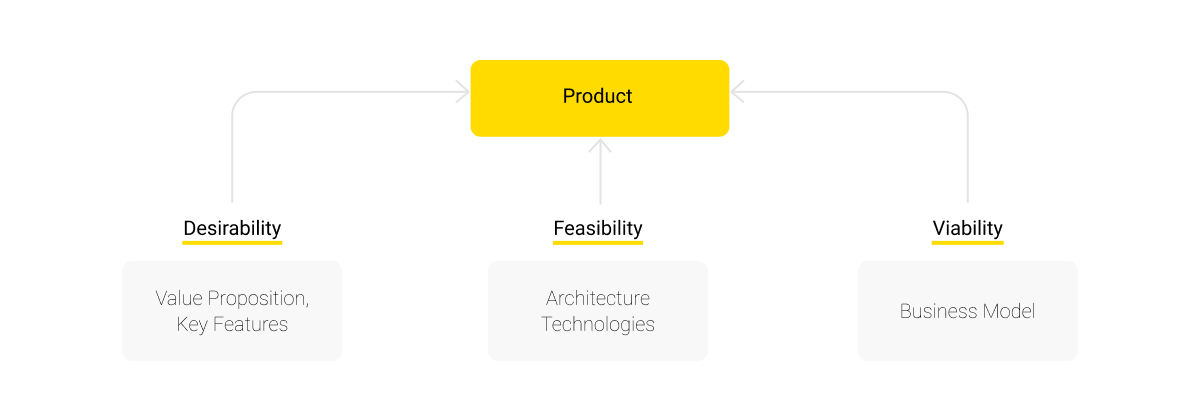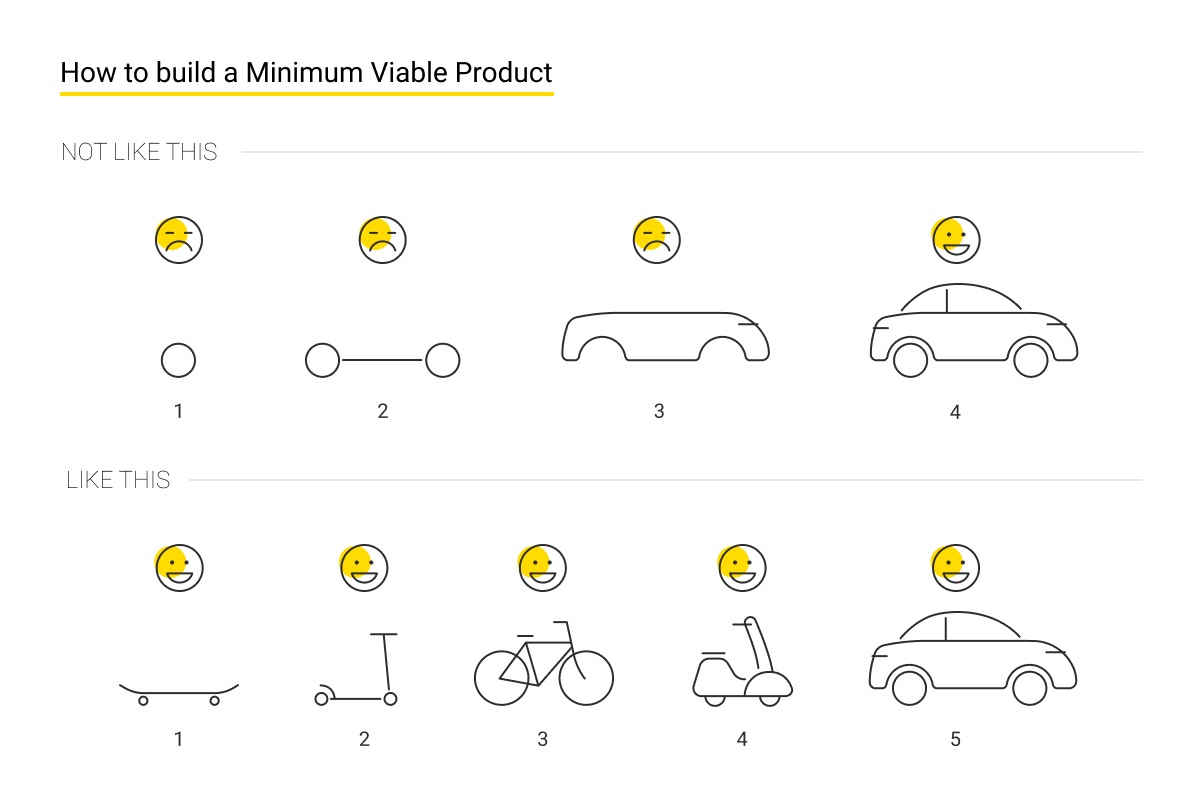- How to build an MVP? Let’s begin with a definition
- Rationales behind launching an MVP development process
- More detailed purposes behind the steps to build an MVP
- MVP development stages in the first approximation
- Impediments to development efforts
- Wrapping up
Assume you, as a business-minded person, have generated a seemingly promising and lucrative idea. If you’re serious about capitalizing on it, in the capacity of an entrepreneur, you will start asking yourself subsequent qualifying questions. The most self-evident ones include:
- Does a real-world market need exist for a product based on my idea?
- Who is my target audience?
- What is its crucial functionality that will cover their previously unmet need in the unique market niche?
The information arising from these queries must be determined before the full-fledged development stage commences, since they lay a foundation for crafting a successful solution that is relevant, necessary for future end-users, and scalable enough. That is why we at Andersen have decided to re-examine the value of an MVP development process. As a trusted and highly ranked vendor of MVP development services, our talent has accumulated extensive multi-faceted experience in this domain, in all involved processes and stages.
So, here is our brief MVP guide.

How to build an MVP? Let’s begin with a definition
Statistics are unequivocal. As many as 90% of all startups eventually fail. Each business story is unique. Efforts made by young aspiring teams get undermined by different constellations of factors, at varying stages. Yet, researchers still have some dependable data to analyze. Per CB Insights, having a flawed business idea, in one way or another, is responsible for the following discouraging situations:
- No market need at all (35%);
- Getting outcompeted by similar yet better prepared projects (20%);
- Unworkable business model (19%);
- Wrong moment to launch a product (10%).
All these causes have something in common. Properly and timely taken MVP steps could prevent them.
Any MVP, aka a minimum viable product, is the inceptive version of a digital tool with a vital core feature that suffices to operate in the market and deliver real value to its users. MVPs might have no polished UI, may have no localized versions for all needed regions, no gold plating, no extra functions, or other minor attributes. However, if all relevant development stages and processes are considered while engineering an MVP, the latter can do one major thing. It can try to address a tangible pain point experienced by a chosen target audience.
Thus, the rationale behind building an MVP, with all the required processes and stages, is the ability to swiftly and cost-effectively test a raw solution. When the hypothesis behind an MVP proves to be right, this shows the potential of the app to bring greater utility to end-users in the future, in which case the resultant spending will be justified.
Concurrently, if the hypothesis proves to be wrong, it can be abandoned for good, which saves any company from wasting substantial effort, time, and funds on fully functional but impractical and purposeless software.
Rationales behind launching an MVP development process
We have arrived at the conclusion that all imaginable MVP development stages and purposes emphasize a single priority, consisting of two parts:
- First, to embody a concept in a limited-scale solution;
- Second, to let early users try it, decide how they feel about it, and gain feedback and actionable insights for potential future changes.
Any minimum viable product shares similarities with a proof of concept (PoC), which serves as a demonstration to substantiate the practicability of a method or idea, proving its eventual functionality.
The PoC involves crafting a defined prototype or test model. The crucial distinction lies in the deliverables: a PoC is not necessarily a finalized product but rather a theoretical corroboration of the basic potential to engineer it. Conversely, an MVP is a fully functional solution with a minimal set of features, designed to provide specific value to the end-user and build upon a clearly formulated software requirements document.

More detailed purposes behind the steps to build an MVP
In a nutshell, all feasible steps to build an MVP, enabling one to craft better software, pursue these three goals:
1. Preliminary validation of business ideas Whether establishing a brand-new startup or enhancing an already existing IT concept at later stages, it is imperative to validate an underlying idea. Assessing the demand for your product is critical. An MVP functions as a tool to test hypotheses using an initial version of software, enabling the evaluation of idea viability through real user feedback.
2. Securing investments effectively Successful user acceptance justifies allocations for your idea. Subsequent refinement of the MVP based on user feedback allows for the removal of redundant features and the addition of missing ones. These adjustments, grounded in feedback and metrics such as downloads, purchases, and UA rates safeguard your investment attractiveness by strengthening your awareness of customer needs and your ability to meet them.
3. Identifying paths for ongoing improvement Once the MVP is released and insights are gathered from users, opportunities for further growth and enhancement of the existing solution become apparent. The rapid and straightforward MVP development processes diminish the time-to-market ratio, providing essential information for seamlessly integrating the new solution with the existing basis and facilitating its large-scale implementation.
NB: How much time, typically, is needed for the development of a minimum viable product, with all the stages and processes? The reply will probably disappoint you, as it is very ambiguous. For instance, Business of Apps cites the following research in the IoT field stating that the timeframe mandated for planning and crafting an MVP can range from three to twenty-eight months. Analytics Insights, not limiting themselves to a given branch, estimate that normally three-to-four months would suffice, yet stress that it could be much more. Based on this, we can probably assume that three months is the absolute minimum.
Now, it is time to zoom in on how to build an MVP.
MVP development stages in the first approximation
Based on our experience, track record, and 100% grip of the importance of your product development process being properly arranged, we would propose these five stages. They are to occur while converting an idea into an MVP.
Stage 1. Ideation process
Primarily, the initial stage involves conceiving a general tech idea capable of adding value for end-users. This entails the organization of brainstorming sessions, development of end-user social profiles, conduction of market research, benchmarking, and exploration of innovative ways to propel the vague idea into a fully-formed concept. The anticipated result of this initial stage is a collection of essential data for subsequent analysis and software design.
Stage 2. Analysis process
Once the information has been collected, the next stage involves thorough analysis to grasp the core unaddressed needs of end-users and identify more efficient paths towards meeting those pain points compared to rivals. Simultaneously, the process to compile a definitive list of features essential for implementing the MVP is crucial, along with a project roadmap, ensuring full alignment among team members concerning priorities and the scope of functionalities to be released. To delineate product requirements, prioritize features, and document them, the expertise of skilled Business Analysts is indispensable. The consensus reached among all stakeholders is a pivotal facet of the Discovery stage, playing a vital role in delivering outcomes that meet customer expectations. By the conclusion of this phase, a clear vision of the app should be crystallized into a specific business plan, outlining precise methods of implementation that are easily accessible for all staff members.

Stage 3. Development process and launch
Once the requirements conceptualization stage is complete, one is able to initiate the development process. It is crucial not to dedicate excessive time to crafting documentation, designing interfaces, and creating prototypes, as doing so may compromise the primary pro offered by an MVP: a swift time-to-market. While the development of a comprehensive IT system might extend over several years, it is feasible to devise and launch a solution featuring a minimal set of essential features within a timeframe of three to six months. At the conclusion of this stage, a fully operational piece of functionality is introduced, delivering tangible value.
Stage 4. Feedback assessment process
Upon launching the app, gather user feedback to gain insights into its strengths and weaknesses. This information collection process is crucial for identifying needed efforts to improve service quality and determining the success of your software, helping you make informed decisions regarding further resource allocations.
Track key user engagement metrics, including:
- Sign-up numbers;
- Active user percentages;
- Paying user percentages;
- Customer lifetime value, etc.
These metrics serve as indicators of your solution's success among users. Executing A/B testing is also beneficial for validating hypotheses. This process necessitates thorough data analysis, providing invaluable insights into the impact of different subscription models and various interface variations. Additionally, consider utilizing crowdsourcing techniques such as discussion boards, social media threads, and Q&A sessions to encourage users to express their impressions of the app.
Stage 5. Integrating the outcomes with business models
Utilize acquired insights to draw conclusions concerning the advancement in the development of the product, which will evolve gradually from a minimally viable state to its fully-functional end result. In the event that the concept proves unprofitable, it enables one to discard it with the slightest possible financial impact and pivot to an alternative idea. Having revisited a regular sequence of MVP development stages, let’s now elaborate on potential impediments.
Impediments to development efforts
The limited development scope and curtailed features do not imply that the process will be universally smooth and trouble-free. Quite the contrary — initial steps are often the hardest, especially when an MVP development task force has to feel its way in darkness.
Obstacle to fruitful processes #1. Poorly researched markets
Ensuring the utility of your app for the intended group requires comprehensive market research performed by knowledgeable BAs before initiating the MVP development.
Insufficient research, on the other hand, leads to unclear functionality, an inability to identify competitors' offerings, a lack of comprehension of the target audience, uncertainty about which features are necessary to match their demands, and challenges in adapting your solution for success.
Consequently, flawed research becomes a critical factor in the ultimate failure of your development processes and IT project as a whole.
Obstacle to fruitful processes #2. Novice development teams
At times, businesses choose to employ less-experienced teams for crafting an MVP, believing it to be a budget-friendly alternative. As a rule, later, they will still have to seek a high-caliber group to complete the development process, having lost time and money.
Two process-related considerations are at play here:
- First, engineering a simplified product does not mean it is allowed to be primitive and flawed. These are different things;
- Second, building the final offering on the foundation of an inferior minimum viable product will universally bring about a significant decline in quality, accompanied by unfavorable feedback.
So, insufficient expertise and inadequate planning contribute to chaos in all project processes, at all stages. Therefore, it's crucial to ensure that any team member hired possesses a track record of proven expertise in custom software development, including not only coding per se, but also modern techniques and productive processes.
Obstacle to fruitful processes #3. Excess of functionalities and niceties
It is highly advisable to refrain from incorporating additional features in the elementary version that do not address fundamental user needs. When attempting to integrate numerous desirable features into your app, engineering price tags and time commitments are likely to increase significantly. Features that are not essential for technically adequate functioning can be incorporated in subsequent upgrades.
Obstacle to fruitful processes #4. Overdrive for excellence
Startups frequently invest excessive precious time by overcomplicating processes, striving for a flawless solution by continually refining its capabilities and look-and-feel. Nevertheless, early adopters do not necessarily demand perfection unless a particular feature adds tangible value. The primary objective of the earliest version is not to achieve perfection. Rather, its purpose is to furnish businesses with insights that aid with the development process aimed at the ultimate digital product.
Wrapping up
Any sort of entity is in the right position to capitalize on properly created minimum viable products.
If you run a startup or a small business, it would be helpful in verifying the actual feasibility of your idea and business endeavors, thus, guaranteeing the profitability of the concept when brought to life.
In case you already bear responsibility for a large-scale and well-established enterprise with a global reach, an MVP will constitute the groundwork for upgrading existing solutions, making your organization more Agile and resource-effective.
Andersen’s talent pool of BAs, UI/UX designers, engineers, QAs, PMs, etc., takes pride in our extensive experience in all relevant processes and stages. We are ever-ready to discuss your IT project, advising you on the most productive measures to take.
Reach out to Andersen to envision and craft outstanding software with us as your trusted partner and provider of engineering services.














